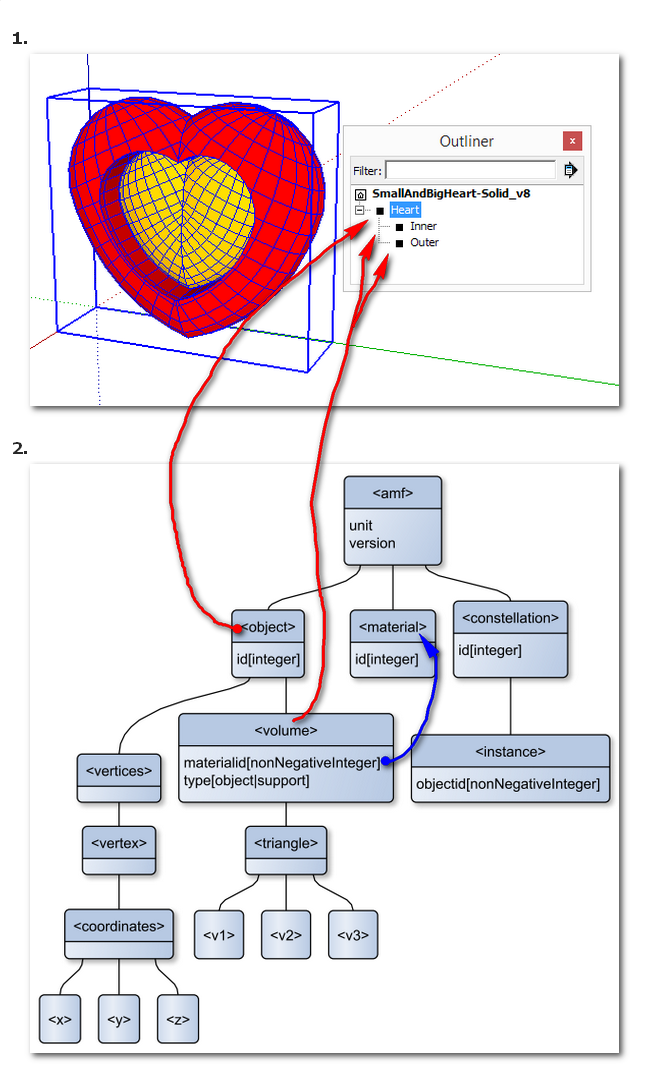Plugin Request: Export as .amf
-
Well, if the units are ignored, then you just have to know, that you have to convert your work to mm for 3D printing software, for now. This problem does not stop using possible amf exporter? This is a s frontline thing now. Slic3r & Cura at least ahead now, perhaps others come soon to support amf. I'm trying to find information...
-
If Jim's exporter always converts the dimensions to 'mm' and puts that in the header 'unit=', then it should work just fine anyway - importers of the data will either assume it's 'mm' anyway, or use the header data and use 'mm' from that ?
-
It is astonishing that the units are being ignored in Cura. STL's lack of units was a primary motivation behind inventing the AMF format.
An AMF exporter is still possible, but Cura's ignorance of AMF units makes it difficult to take Cura seriously.
Moving on..
Let's talk about expectations for the SketchUp model as they relate to AMF. AMF primarily expects solid volumes. These volumes map nicely to SketchUp solid Groups and solid ComponentInstances.
Does it make sense to have the exporter only work on solid objects in SketchUp?
Can you share a SketchUp model that you would expect to be exportable to AMF?
-
A solid two colors SketchUp file: SmallAndBigHeart-Solid.skp
I check my stl files on Netfabb Or before that SU Solid Inspector. Sometimes NF says that my file is printable even when SketchUp Solid Inspector shows problems. NetFabb can export amf,but not import. And it's only a repairing models software.
For 3D printing the model has to be solid. Usually I prefer to do:SU -> Netfabb -> SU or print.
Slic3r also do not recognize inches. A bunch of other slicers do not accept amf, yet.
-
I think it makes more sense to organize the model using Groups or Components. So in the image the Heart is the amf <object> and the 2 sub-components are <volume> elements. AMF Volumes are solids, have a material, and can not over-lap.
Material would be applied to each sub-component (volumes), but not the top-level Heart (object.)
Using Groups/Components also has the advantage of instantly knowing if they are solid or not.

-
As a side note, Microsoft has included some support for printing to 3d printers[1]. There is a 3D Builder app[2] in the Microsoft store which loads .stl, .obj, and .3mf - Microsoft's version of .amf.
I think I read Microsoft has licensed NetFabb technology for checking files.
Maybe soon we will be 3d printing directly from SketchUp.
[1] http://blogs.windows.com/bloggingwindows/2013/08/22/3d-printing-support-in-windows-8-1-explained/
[2] http://apps.microsoft.com/windows/en-us/app/3d-builder/75f3f766-13b3-45e9-a62f-29590d5781f2
3D Printing in Windows:
http://msdn.microsoft.com/en-us/windows/hardware/bg183398 -
Test files round 2.
The amf appears to load in the AMF Utilities, Cura, and Slic3r.
-
Hi! Everyone do not like Microsoft's closed format:
http://fabribles.com/forum/vox-pop/70-microsofts-3mf-file-format-no-thanks
Slic3r & Cura can run on Windows, Mac OS X and Linux. They seems to have continuing updates & fast development which I cannot always say from MS products.
Slic3r & Cura also have model fixing. I just think that a good model do not need holes filled with small triangles. Probably slowing the printing process? Or at least I try to do so clean model as possible usually.
One part of the 1:3 skull: GrabCAD -> Meshlab -> SketchUp -> NetFabb -> Cura -> 3D Printer.
-
Microsoft's 3MF format is not a "secret" format. It is a .zip archive. In the archive is an XML file that is nearly identical to the .amf XML format. The archive also contains meta-data which can be used by applications. 3MF is practically .amf with support files. Not sure why people don't like it besides ignorance or having a prejudice against Microsoft.
Microsoft's 3d Builder also uses NetFabb technology for model repair.
For better or worse, 3MF has a better chance at becoming a standard then the current "standard" which doesn't seem to be going anywhere because it is Design by Committee.
-
Relevant, if you haven't seen it yet: http://online.liebertpub.com/doi/full/10.1089/3dp.2014.1508
Professor Hod Lipson's, AMF tutorial, Part 2
-
I didn't see that, thanks Marcus.
Colors and textures seem fairly straight forward. There is a color hierarchy similar to SketchUp where Face (amf triangle) color over-rides Group/Component (amf Volume or object) color.
In amf, vertices may also have a color although I am not sure how that might be represented in SketchUp.
Advertisement







